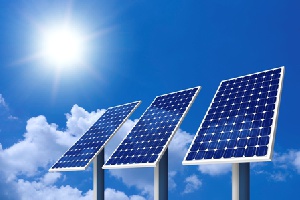“I am disappointed with our approach to solar,” says Dr. Kwabena Donkor, Chairman of the Parliamentary Select Committee on Energy and Mines -- and he is not alone in thinking that government’s pursuit of grid-connected solar energy is misplaced.
For fear of losing their jobs, they are not saying it openly, but technocrats in the energy sector are equally murmuring disquietly over government’s pursuit of grid-connected solar energy when cheaper forms of energy are needed to take care of base load.
“The director of renewable energy at the Energy Ministry nearly lost his job when he opposed the idea,” said an insider source.
Ghana has a basic energy problem, managers of the power sector argue, and many of megawatts of power are needed to solve it while money is not readily available.
The country would therefore be better off if it invested in cheaper sources of energy for the national grid while relatively expensive solar energy is encouraged for individual deployment.
Aside from increasing cost for consumers, grid-connected solar requires large tracts of land for the mounting of Photovoltaic (PV) panels. For just 2megawatts of solar energy at Navrongo for the national grid, solar panels had to be mounted on 3.4 hectres of land. And it cost the country about US$9m when a megawatt of thermal energy costs about US$1million.
Meanwhile, the sun’s rays are having a field-day on rooftops and making staying indoors a sweaty business for many Ghanaians.
Manufacturers of Photovoltaic (PV) panels are aggressively seeking markets in Africa, and in doing so they are seeking to take advantage of feed-in tariff regimes where they exist -- like Ghana.
Indeed, B&FT sources indicate that some of the companies are asking for tariffs higher than what Ghana has gazetted.
Germany, a leader in PV technology, has been aggressively seeking entry into the Ghanaian market; last year it gave Ghana €1.8million to support implementation of the country’s Renewable Energy Act, which envisions a 10% penetration of solar, wind and biogas in the energy mix by 2020.
Eight German PV companies visited the country recently and held discussions with various government agencies -- and their focus is on grid-connected solar, which is much more convenient and, as it were, guarantees a quicker return on investment.
They have since been training Ghanaian technicians on how to install grid-connected solar panels. Dr. Kwabena Donkor, who is a former Deputy Energy Minister and a Member of the Chartered Institute of Energy, argues, however, that Ghana should be the one determining what is in its best interest, and that whichever investor comes should tailor their investment to fit into the country’s plan.
“Our peak demand is from 6pm to 11pm, and at that time grid-connected solar will not be available. The only other possibility is to store it, and doing so will add at least fifty percent to the cost,” he said.
The country’s building code, he told the B&FT, should be amended to make it mandatory for new public buildings as well as private estates to incorporate solar energy.
Instead of spending a lot of money extending the national grid to remotely located and sparsely populated rural communities, solar energy should be deployed for such communities to power schools and health posts, he added.
In the western world, where renewable energy has become fashionable, coal and other cheaper sources of energy remain basic to their needs.
Over sixty percent of global energy used is still generated from coal.
Some of the grid-connected solar projects being pursued in the country include the proposed 155megawatts solar plant by UK-based Blue Energy, which is expected to become Africa’s largest solar plant; and SADA’s proposed 40megawatts in Tamale, among others.
The last time the B&FT checked, the Energy Commission had issued over 20 “provisional” licences for grid-connected solar projects in the country, with a total generation capacity of over 1600 megawatts.
Business News of Saturday, 9 August 2014
Source: B&FT

















